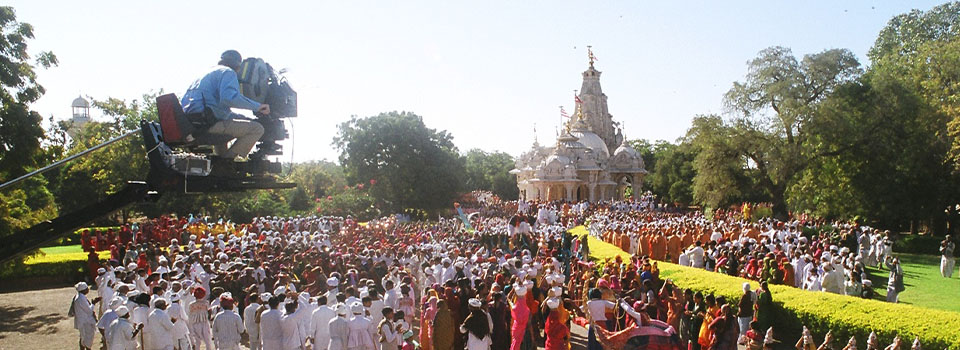Behind the Scenes

-

The Story
BAPS, an international NGO, has a rich experience of presenting Indian culture to over 55 million people worldwide through its 9 cultural festivals and 5 permanent exhibitions at Akshardham – New Delhi, Gandhinagar and Shri Swaminarayan Temples - London, Toronto and Nairobi.
As part of its continuing activities, In early 2001, BAPS decided to make a film that would show the true wealth of India – its culture, its heritage and its wisdom. To make the film more interesting and take the audience into it with a story, it was decided to present India through a unique inspiring person – Neelkanth. This would give the opportunity to present a docu-drama rather than a documentary. Neelkanth, the child yogi, was born over 200 years ago. Neelkanth renounced his home at the age of 11 and walked across India for seven years. This gave the opportunity to film across India, showing its diversity and its binding threads, through the unique and interesting story of Neelkanth traveling all alone across these 8,000 miles. The story was decided, now the medium had to be specified and planned...
-

The Medium
Since the best picture and sound would be possible in large format film, it was a foregone conclusion that this clear and crisp ‘large-format’ film would be the best medium to use.
Large Format film is 70mm film on which each picture is eight to ten times bigger than normal 35mm film, which means a clearer projection on a much larger screen – up to 100 feet high. This is a difficult medium to film in, because of the clarity and depth of the film, which makes it more challenging for the cameraman in getting the right frame. Very few stories have been filmed in large format, because of this difficulty and hence a higher expense. Even BAPS was able to afford this filming only because of the volunteer effort, without which this film would not have been possible.
-

The Beginning
Thus began the challenge of producing an large format film. It kept a BAPS professional team and experienced industry crew busy for the next three years with the planning and execution of this film.
Right from Authentic research (on India and Neelkanth’s story) to Story & Script development; from Location search to Shot design; from Production Design to Shooting Logistics; from Editing to Music, each and every BAPS volunteer took up the large format challenge. The first step, of course, was the research on India – the India of today, the India of 200 years ago, and the India of centuries ago.
-

Research & Story development
India is an ancient civilization with contributions in all spheres - from science to art, language to mathematics, philosophy to chemistry.
Research into these fields was carried out by a team of BAPS historians who referred to old texts, met other experts, went to many ancient sites. Research on the central character of Neelkanth was conducted with 200 year old books and illustrations of those times. These BAPS researchers spent one year referring to more than 270 books in 17 libraries and private collections. Since this film was based on a true story which took place 200 years ago, the authenticity factor underlined everything. Prized resources included the original books and drawings published by the British Government and books of other explorers who traveled through India at that time. Apart from research for the story development, the costumes and settings had to reflect the people and places of 18th century India, to transport the audience back in time. The BAPS researchers took every detail of what villages, clothing, and monuments looked like 200 years ago. Many hundreds of hours went into this research. The research was done, now we had to look for the right professionals to shoot the film and the right locations where to film...
-

The Crew
BAPS extensively researched historic manuscripts and briefed the complete story to Kamlesh Pandey. Using this brief with the authentic documentation, research papers and historic manuscipts, scriptwriter Kamlesh Pandey crafted the original Hindi script.
Nearly 100 large format professionals were consulted. After this worldwide search of meeting Directors, DPs, post-production Laboratories and many other professionals, BAPS brought on board Director Keith Melton, Director of Photography Reed Smoot and Writer Mose Richards. Each of them well known in the industry and with years of experience with large format films. Later, Music Composer Sam Cardon, with nine large format films to his credit, added to the high quality team making this film. With BAPS acting as overall Producers of the project and providing key infrastructure and logistics, including research, art department, wardrobe, locations, legal, casting, and volunteer support, this high quality team of large format film industry experts provided guidance and expertise to make this a high-value production. They were, of course, more than ably helped by the large-format experience of the USA crew, brought together by Keith Melton. With people like Reed Smoot (DP), Neal Allen (First AD), Bobby Adams (Grip), Dennis Peterson (Gaffer), Scott Hoffman (First AC), Tim Lovasen (Second AC)... the crew was a top-notch team from the large-format industry, with the experience of an average of seven to ten films each, and many years of work in the industry. While the crew was being selected, work on scouting for locations was also in progress...
-

The Locations
For a period film, and an large format film at that, a location has to be as far away from ‘civilization’ as possible, so that no electric cables, telephone poles or modern homes are visible – and yet be near an easily accessible road so that it doesn’t take time to reach and set up the shots. These opposing requirements were only part of the constraints for the location scout.
A team of BAPS volunteers scouted more than 250 locations through out India – from Nepal to North India to Kerala in Southern tip of India, from Gujarat to Assam, covering more than 22,000 miles! Simple things like finding a location with an isolated Banyan tree without electric cables or poles nearby took days of scouting in remote villages. This was done in the scorching summers when the temperatures were often higher than 110 degrees Fahrenheit. After the locations for different scenes were decided, the shots had to be set up to ensure that no modern objects were visible. This was where the Production Design department came in.
-

Production Design
Production Design for a period film is as difficult as the location search. Once selected, the locations had to look as the scene would have been 200 years ago. Therefore, a mammoth effort was undertaken by BAPS to re-create many locations to look as they were 200 years ago. Mud huts, thatched roofs, wooden doors, oil lamps, ox-carts... many constraints had to be kept in mind to recreate India of two centuries ago.
BAPS’ Art Directors and Designers researched these places to get the exact measurements and design details, old photos and references, and local opinions on older structures. All of this was converted into computer drawings. A team of 200 volunteers consisting of engineers, artists, welders, and carpenters worked on the production design to make it feel authentic enough for the clarity of an large format screen, which would show each detail clearly on a large screen. The town of Neelkanth’s childhood, Ayodhya in Northern India, was visited by the BAPS designers. They mapped out the current town, its streets and the course of the river. Then researched locally on the houses which used to stand 200 years ago – locating the neighborhood sweet shop, the nearby temple, the street’s largest house... and then sketching the area as it was, 200 years ago at the beginning of Neelkanth’s journey. The sketch was verified by history professors and an architect for historical accuracy in the design and materials that would have been used in Neelkanth’s time, and then converted to computerized plans for the set construction. The drawings were then converted to huge three-dimensional sets, three streets of old Ayodhya, seen for the first time as they would have been two centuries ago. Every detail including the intricate peacock design on top of the wooden frame of the sweet shop’s door had been researched, drawn, computerized and then finally made in wood, brick and plaster! The same attention to detail and readiness for hard work also showed in the selection of the central cast and the costuming.
-

Casting
As the central character and a representative of India’s mysticism in the film, Neelkanth had to look the part. The real Neelkanth, 200 years ago, had been thin and starved himself as part of his ascetism, yet had bright eyes with love, confidence and courage shining through. Searching for the same look entailed a huge search stretching across the country, videotaping 11,000 children throughout India and finally selecting the two who play younger and older Neelkanth.
The call sheet on 08 February 2004 showed a cast of 20,000 children to be filmed together at Akshardham in Gujarat. This was a unique voluntary effort – a children's voluntary convention where they gathered from different regions and different economic backgrounds to reinforce the message of Unity in Diversity. First AD Neal Allen said, “This is unimaginable in the film industry. Only BAPS can do it”. While this was the highest cast assembled for any one scene, the Akshardham Arti scene had 9,000 cast while the Rath Yatra scene had 8,000. With a total cast of 45,000, Mystic India had the biggest cast ever in any large format film. Director Keith Melton said about the huge 8000 cast, at the end of the Rath Yatra scene shoot, “Were it not for the wonderful discipline, cooperation, patience, and dedication of the BAPS extras, this moment would not have been possible.” Participating as actors was only a small part of the work that BAPS volunteers performed – they managed most of the film’s production and other departments...
-

570 Volunteers
Mystic India is unique not only because it is the first large format epic on India, but because of the way and the spirit in which it was made. Volunteers donated their time and efforts selflessly for this film, free of charge. Professional, engineers, doctors, students, businessmen and government officials – all took leave from work or school to help create Mystic India.
All the work added up to a mammoth One Million man-hours over two years, which were all volunteered free of charge by these professionals. A networking scientist took a three-month leave from his job at the Indian Space Research Organization (ISRO). A visual arts student took a year off from university in Nottingham, England. An advertising expert quit his advertising job for one year while a young transport business owner delayed his marriage plans till after the shoot. The list would be endless... Each of these 570 volunteers made their best contributions, yet chose unanimously to remain unnamed in the film’s Credits – they were not working for money or fame, but for this epic film about their country. The film does not name any of them in deference to their wishes that their service to India as a country and Mystic India as a representative of their culture remain unnamed.
-

Principal Photography
Once the planning for the film was done, the actual shoot began... with its daily challenges and changes in spite of the detailed planning.
Principal photography began in Pokhara, Nepal on March 5, 2003. Beautiful aerials of the Himalayas were captured. Many of the shots show Latesh Patel with nothing on but a dhoti (loin cloth) in the freezing temperatures, a pebble in his surroundings at 13,000 feet. In preparation for the snow shots, ten-year-old Latesh spent two weeks training and acclimatizing near Everest Base Camp. The next scene of Akshardham Arti scene was filmed over two days. On the first day, a shot was needed that included about 9,000 volunteer extras holding lit lamps and singing in unison as the sun was setting. With each candle lasting 20 minutes, and with a perfect “shooting window” of only about 10 minutes, everything had to be exactly in place. A massive crane shot, the logistics and choreography of getting 9,000 candles lit at the same time, people moving and singing in sync, had to be carefully coordinated. Many other shots presented different challenges – how to maximize the impact of the Sun Temple with its large pillars and deep stepwell in front; lighting up a 200 feet street set at Ayodhya for a rainy night scene; shooting from a boat in rapid river water. Another scene of arti at Haridwar in North India was shot throughout the night, with over 500 extras staying awake till dawn for the shoot. After 9 weeks of continuous shooting, phase- 1 principal photography came to an end. The next phase of shooting began on January 26, 2004 in Jaisalmer, the city of golden sands and stone in Rajasthan. This second phase of shooting took place at more than 50 locations in Rajasthan, Gujarat and Delhi. This shoot had a unique and very exciting shot of 20,000 children at Akshardham singing the National Anthem with Indian tricolor flag in their hands. The shots at Jaisalmer with 5000 extras and Sarangpur with 3000 extras were equally exciting. This shoot involved extensive traveling. The crew traveled more than 6500 kms in 21 days of shoot – an average of 310 kms a day! Another additional phase of filming was the still photography undertaken for panoramic panels which are part of the film – for Art and Architecture photos, a three-man crew traveled with large format still cameras an additional 7000 miles, by road, presenting four unique art and architecture panels in the film, with 300 unique photos of amazing architectures of India. This also yielded the over 250 ‘faces’ of India stills – shot across India to put together the diverse looks of India, united in this film. Remote locations like Muktinath in Nepal and mountain lake Devariya Taal, which is accessible only by trekking, were also included in this phase. For everyone involved, the whole shoot was a unique experience and had a never-before outcome. Director Keith Melton says, “Mystic India has an amazing visual panorama. The audience will experience a unique, multi-layered view of India that is both intimate and spectacular.” It was then time to compose similarly unique music to uplift and highlight the strong visuals...
-

Music
The music, like the rest of the film, is a fusion where East and West harmoniously and seamlessly meet. The composition too was a meeting of West – Sam Cardon and East - Ronu Majumdar.
Composer Sam Cardon enjoyed the experience of learning about Indian instruments and ragas and incorporating western symphony into the score with the Indian music. After many meetings to design the appropriate music with the BAPS team and Ronu Majumdar, all experts in Indian music, the theme and score was designed. After including music from various regions of India, different instruments were recorded by some of the best artistes of India under the supervision of BAPS volunteers at Mumbai and Ahmedabad, and the western symphony at Seattle. Around 60 different artists were recorded for authentic Indian music providing traditional classical Indian music – with unique fusion of a 75 piece western orchestra of Seattle. Indian and western music was mixed at Salt Lake City with experienced mixing engineers helped by BAPS volunteers on Indian parts. Incorporating this music, sound and visual effects was then part of the post-production...
-

Post-Production
David Bartholomew worked enthusiastically on getting the negatives to see the light of day – making positives and checking the film, often marveling at the quality of the shots and calling up India enthusiastically just to praise the scenes, the sets and the splendid camera work.
Visual effects also added some magic to Mystic India. The still transparencies of monuments and shrines and tourist interest places were scanned at BAPS facilities. All the graphics and compositions were prepared by BAPS. Amalgamated Pixels of LA applied their expertise and combined knowledge to the exercise of merging the film with visual special effects and stills. Michael Morreale of Amalgamated worked hard at transferring the digital files of high resolution onto large format film which could be projected to large format size and adequately showing their splendor and majesty. One of the most innovative shots, utilizing traditional and next generation filmmaking techniques, was the 360-degree yogic posture shot. The scene shows Neelkanth, in the changing seasons, growing older on screen. All the while, the camera is slowly circling around him as snow falls, followed by rain and lightning, the growing of flowers and the flying by of butterflies and birds. Green screen shots were filmed in Ahmedabad, India. The background plates were shot in Nepal. The whole scene was put together in Los Angeles, California. This film is a true worldwide effort of talented filmmakers to bring India to the eyes of millions.
